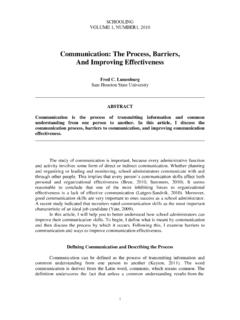Transcription of FACULTY OF HEALTH AND SOCIAL CARE SCIENCES
1 FACULTY OF HEALTH AND SOCIAL CARE SCIENCES Service user involvement in the design and delivery of education and training programmes leading to registration with the HEALTH Professions Council Professor Mary Chambers FACULTY of HEALTH & SOCIAL Care SCIENCES Kingston University and St George s, University of London Dr Gary Hickey FACULTY of HEALTH & SOCIAL Care SCIENCES Kingston University and St George s, University of London Acknowledgements We wish to thank the HEALTH Professions Council for commissioning the research. We also wish to thank members of the Steering Committee and Advisory Group for their guidance, help and support throughout the project with special thanks to Denise Forte for her assistance with the recruitment of Service Users.
2 Thanks also go to Sally Wilson Service user Researcher for her contribution to data collection and analysis. To all Service Users and other study participants we wish to acknowledge the time and energy you gave to the project for which we are most grateful and we take this opportunity to thank you. i Executive Summary Background The HPC is a regulator of 15 HEALTH professions and its role includes approving and upholding high standards of education and training. Noting the trends toward greater SUI in education, the HPC is considering whether to develop a Standard of Education and Training (SET). This would require education providers across all those professions which fall under its regulatory umbrella to ensure SUI in the design and/or delivery of education and training.
3 Purpose and objectives of the study To help them reach a decision the HPC commissioned research to explore the current involvement of service users in the design and delivery of pre-registration education and training programmes approved by the HEALTH Professions Council (HPC). More specifically the overarching research objectives were as follows: To gain improved understanding of the nature and extent of service user involvement in the design and delivery of approved education and training programmes which lead to registration with the HPC. To identify, analyse and evaluate the different types of involvement activities undertaken by approved education providers. To situate the above within the relevant literature on service user involvement (in particular, within education and the regulation of education).
4 The study objectives were to: Identify the existing approaches and types of SUI activity across the range of programmes regulated by the HPC Identify existing best practice criteria for SUI in education and training Identify the drivers, benefits and challenges of SUI in education and training Produce options for Standards of Education and Training (SETs) for SUI in the design and delivery of HPC regulated education and training programmes ii Methods The study was conducted in four interdependent stages, employing a mixed method approach utilising both qualitative and quantitative methods of data collection. Following the literature review, and building on the theoretical framework a matrix of benefits and barriers to, and facilitators of SUI was developed.
5 This theoretical framework and matrix was used to inform the development of an on-line questionnaire and the key elements for discussion in the focus groups and individual interviews as part of three case studies. Findings were then discussed at a consensus workshop and options for SETs developed. Findings Three key sources of drivers can be identified: service users and public, professions and Government policy. Drivers include the emergence of the service user movement, public distrust of professionals, a shift away from a medical model of care with service users as passive recipients of services towards a more empowered approached where service users are involved in decision making; and a range of Government legislation, which encourages greater inclusion of service users than hitherto.
6 Service users were involved in various aspects of the design and delivery of education and training. Of particular note is involvement in programme planning, the development of teaching tools/materials, formative feedback on the programme, role play in the classroom and module planning. There were no professions, which responded to the questionnaire, which indicated that they did not involve service users in some way. The range of perceived benefits of involving service users in education and training include those for students (for example, students gain insight from service users perspective (82%), challenges students stereotypes/assumptions of service users (73%)), the programme (for example, ensures the priorities of service users are reflected in the programme (71%)) and also the service user (for example, provides an opportunity for service users to share experience and/or expertise (74%) and ensures that service users feel valued (73%).)
7 One key issue was defining service user . A suggested option is to use the phrase end recipient of a service . Such a definition would be consistent with what is generally meant by the phrase service user and is sufficiently broad to enable the inclusion of those few professions, for example biomedical scientists, who rarely, have face-to-face contact with the public. This definition excludes students and academics. Some respondents have expressed concerns about the extra demands on infrastructure, culture and resources as a result of a SET. This issue is particularly iii significant in a time of economic constraint. A variety of approaches were proffered for addressing these challenges. Developing a SET Although there was widespread support for including service users in the design and delivery of education and training there were many concerns about the value of introducing a SET and of introducing a SET immediately.
8 This leaves the HPC with a range of options Change nothing Introduce a standard immediately requiring professions to involve service users in the design and delivery of education and training Recommend that all HPC regulated professions should include service users in the design and delivery of education and training, but stop short of introducing a standard A standard would be developed but not introduced until a specified time in the future Any SET should not be a tick box exercise or encourage tokenism. The SET should be encouraging of a meaningful level of service user involvement . Meaningful refers to the extent to which service users are involved and/or the level of influence that they have over an aspect of education.
9 In terms of standards, the following options were developed for HPC to consider: 1. Service users are actively involved in the design and/or delivery of the programme with supporting evidence. 2. The design and delivery of the programme must be influenced by service users, carers and representatives. 3. There must be a service users group which considers that it has had appropriate input into the management, design and delivery of the course. Table of Contents Chapter 1- Introduction and background .. 1 1 Purpose .. 1 Study Objectives .. 1 Background .. 2 Drivers for SUI .. 4 Models of SUI .. 7 Summary .. 10 Chapter 2- Literature Review .. 11 11 Benefits of 15 Facilitators and Barriers .. 18 Conclusion.
10 26 Chapter 3- Methodology .. 28 28 Stage 2 - Development of a matrix of benefits and barriers to, and facilitators of, SUI to inform stage 3 .. 28 Stage 3 - Two concurrent phases: an online questionnaire survey and case studies . 29 Stage 4 Consensus Workshop .. 33 SUI in the study .. 34 Ethical Approval .. 35 Chapter 4- Findings .. 36 36 Questionnaire respondents .. 36 Who are service users? .. 38 Aspects of education and training in which service users are involved .. 39 Potential benefits of SUI .. 41 Perceived benefits to service users .. 43 Potential facilitators of SUI .. 44 Views on standards in education and training .. 45 Challenges .. 56 Additional comments .. 66 Issues emerging from the focus groups and interviews not addressed elsewhere.



